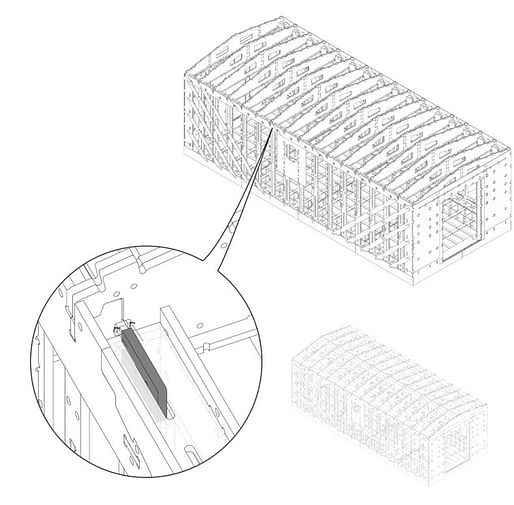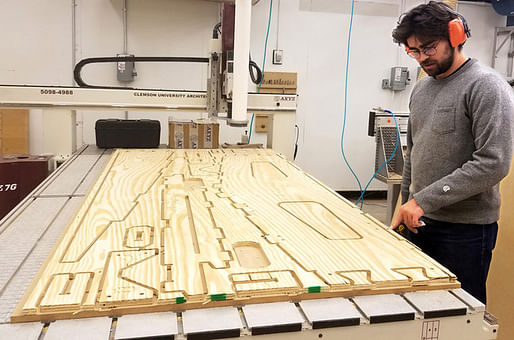
“With a click of the button, someone could order a custom-cut, flat-packed home online, and construct it by hand with the help of their friends and neighbors in a matter of days,” states Kate Schwennsen, professor and director of the School of Architecture at Clemson University. Students at the school have created a construction method that could significantly ease the building of low-tech sustainable housing.
Comprising an interlocking tab-and-slot connection system, the sim[PLY] Framing System is “intuitive and easy”, according to the press release. The buildings “come together much like a 3D puzzle” without nails. Instead, connections are fastened using steel zip ties and screws. That means disassembly is just as easy.
The system uses locally-sourced plywood that has been CNC fabricated. All construction plans are digital and can be used by any CNC router.


Larry Sass @ MIT has been doing this for at least 10 years.
Not to belittle the concept, because I think it's great, but "created" might be an overstatement.
I am one of the faculty involved with this project, and I just stumbled across this post.
In response to some of the comments...
The design team is familiar with and knowledgeable of the earlier work by Botha and Sass, WikiHouse, Facit Homes, and others. The work at Clemson is one part of the larger conversation on CNC-fabrication and light framing. Some of the many unique aspects in our system (from connection geometries and details, to sequencing, etc.) are described in the various presentations we give on the project, and in forthcoming academic articles/papers. Related work by other parties is acknowledged there as well. (so stay tuned)
The photo in the post shows an entire class of students at work on one of the prototypes. In reality, all construction could easily be performed by a crew of 2 to 3 individuals.
Finally, comparisons to conventional light wood framing (and its economy) are understandable and important. Systems like the one described in this post should be considered over their entire life-cycle, as they offer distinct efficiencies in onsite construction plus longer-term advantages in thermal performance, etc. (again, stay tuned for other articles)
All 9 Comments
how does this differ from wikiHouse?
It really doesn't, Clemson just needed something to crow about.
I have a much simpler and far less expensive method of building low a cost habitat.
Larry Sass @ MIT has been doing this for at least 10 years.
Not to belittle the concept, because I think it's great, but "created" might be an overstatement.
My thought as well tduds.
alternate facts abound :(
Mean spirited world isn't it.
Quick Google of other systems mentioned led.... no where, despite far more impressive creds, so the question is, why one has not commercialized / popularized in 10 yrs, and the other also gone nowhere fast despite its name dropping name.
I these kids follow through and popularize the system, they will be the winners in the flat pack building contest. I hope they do, we NEED a ground breaking construction methodology.
However, I'd bet I could out cheap, out fast, out customize, out green using standard stud construction and a half skilled crew. It's already known by anyone with any construction creds., materials readily available anywhere at minimal costs. You just need to keep everything on 16 or 24 inch modules.
I am one of the faculty involved with this project, and I just stumbled across this post.
In response to some of the comments...
The design team is familiar with and knowledgeable of the earlier work by Botha and Sass, WikiHouse, Facit Homes, and others. The work at Clemson is one part of the larger conversation on CNC-fabrication and light framing. Some of the many unique aspects in our system (from connection geometries and details, to sequencing, etc.) are described in the various presentations we give on the project, and in forthcoming academic articles/papers. Related work by other parties is acknowledged there as well. (so stay tuned)
The photo in the post shows an entire class of students at work on one of the prototypes. In reality, all construction could easily be performed by a crew of 2 to 3 individuals.
Finally, comparisons to conventional light wood framing (and its economy) are understandable and important. Systems like the one described in this post should be considered over their entire life-cycle, as they offer distinct efficiencies in onsite construction plus longer-term advantages in thermal performance, etc. (again, stay tuned for other articles)
Many thanks for clarifying this (putting us in place).
Cool that it snaps together... But... What is the cost? What are the dimensions? Looks to be 20'*10'... Not code minimums... Competing with manufactured housing? I can get a killer single wide for $25k.
Block this user
Are you sure you want to block this user and hide all related comments throughout the site?
Archinect
This is your first comment on Archinect. Your comment will be visible once approved.